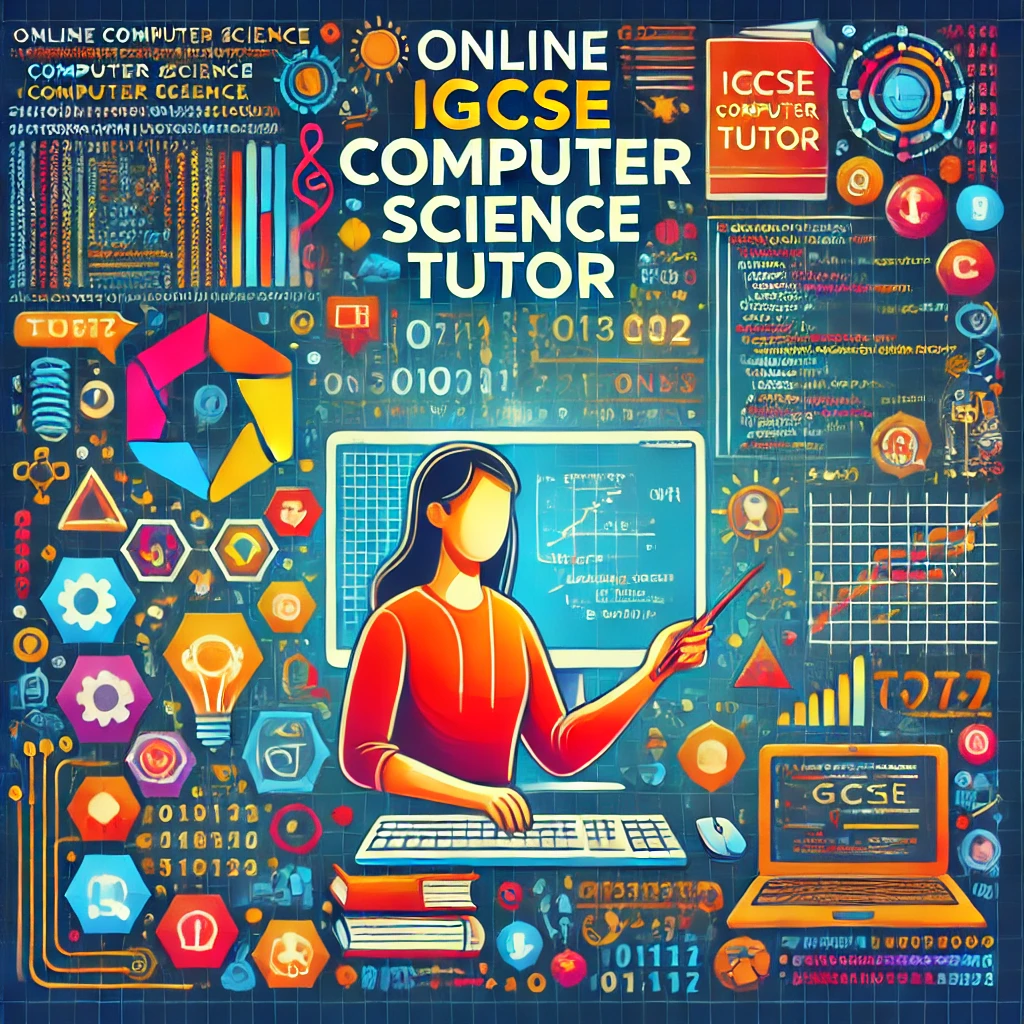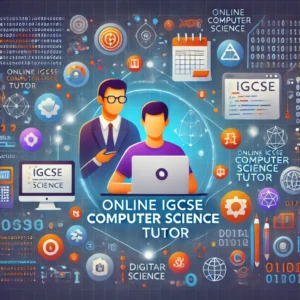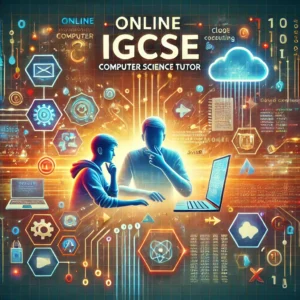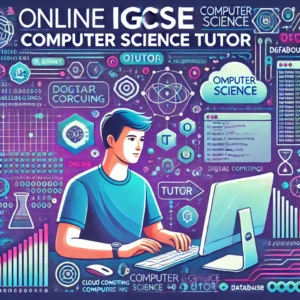Cambridge IGCSE Computer Science (0478) Tutor
IGCSE Computer Science Tutor – Master Programming & Algorithms with Noble Learners
At Noble Learners, our Online IGCSE Computer Science Tutor program is designed to help students excel in the Cambridge IGCSE Computer Science (0478) syllabus. We focus on enhancing computational thinking, programming, algorithms, and logic, ensuring students are well-prepared for both exams and future technology-based careers.

Why Study Computer Science ?
Computer Science is a vital subject in today’s technology-driven world. Mastering the IGCSE Computer Science syllabus provides students with critical skills in programming, problem-solving, and understanding computer systems. These skills are essential for pursuing careers in fields like software development, artificial intelligence, cybersecurity, and data science.
Why Choose Noble Learners for IGCSE Computer Science Tutoring?
Expert IGCSE Computer Science Tutors:
Our tutors are experienced and highly qualified in teaching the Cambridge IGCSE Computer Science syllabus. They simplify complex topics like algorithm design, programming, and data transmission, making them easy to grasp and apply in real-world scenarios.Interactive Learning:
Our online platform makes learning Computer Science engaging and interactive. Students participate in coding exercises, algorithm challenges, and live programming sessions to ensure they get hands-on experience while mastering theoretical concepts.Tailored Tutoring:
We understand that every student learns differently. Our Online IGCSE Computer Science Tutors tailor lessons to individual needs, helping students build confidence in problem-solving, algorithms, and practical programming.

IGCSE Computer Science Syllabus Overview
Our Online IGCSE Computer Science Tutor program covers all key topics from the Cambridge syllabus, preparing students thoroughly for their exams
Computer Systems
Data Representation
- Number Systems: Denary, Binary, Hexadecimal
- Conversions between number systems
- Binary addition and overflow
- Representation of text, images, and sound using binary
- Data storage and compression techniques
Data Transmission
- Data transmission methods (serial vs. parallel, synchronous vs. asynchronous)
- Error detection methods (parity bits, checksums)
- Encryption and data security
Hardware
- Central Processing Unit (CPU) functions and components
- Memory types: RAM, ROM, cache
- Input and output devices
- Secondary storage: Magnetic, optical, and solid-state devices
Software
- System software vs. application software
- Operating system functions
- Utility software
The Internet and Its Uses
- Structure of the internet, IP addressing, DNS
- Web browsers and web pages (HTML)
- Cookies, sessions, and digital currency (blockchain)
Cybersecurity and Emerging Technologies
- Cybersecurity threats: Hacking, malware, phishing, social engineering
- Prevention techniques: Firewalls, anti-malware, encryption
- Automated and emerging technologies: Robotics, AI, and machine learning
Algorithms, Programming, and Logic
Algorithm Design and Problem-Solving
- Program development life cycle: Analysis, design, coding, testing
- Problem decomposition, abstraction, and algorithm design
- Writing and debugging algorithms using flowcharts and pseudocode
- Common algorithms: Sorting (bubble sort), searching (linear search)
Programming Concepts
- Variables, constants, data types, and operators (arithmetic, logical, Boolean)
- Control structures: Sequence, selection (if, case), iteration (loops)
- Procedures and functions with parameters
- String handling, arrays (1D, 2D), file handling
Databases
- Single-table databases, primary keys, data types
- Querying databases using Structured Query Language (SQL)
- SQL commands: SELECT, WHERE, ORDER BY, SUM, COUNT
Boolean Logic
- Logic gates (AND, OR, NOT, NAND, NOR, XOR)
- Logic circuits: Designing and simplifying using Boolean expressions
- Truth tables and logic circuit diagrams
Exam Preparation and Assessment
Our IGCSE Computer Science Tutor prepares students for every component of the Cambridge IGCSE Computer Science exam, which consists of:
Paper 1: Computer Systems
Duration: 1 hour 45 minutes
Weighting: 50% of the total grade
Format: Short-answer and structured questions based on topics like data representation, computer hardware, and the internet.Paper 2: Algorithms, Programming, and Logic
Duration: 1 hour 45 minutes
Weighting: 50% of the total grade
Format: Algorithm design, problem-solving, and a scenario-based question that involves writing an algorithm or program code.

IGCSE Computer Science (0478) Important Questions
1. What is the binary representation of the decimal number 13?
a) 1101
b) 1011
c) 1110
d) 1001
Correct Answer: a) 1101
2. Which of the following is an example of serial transmission?
a) Data sent along multiple wires simultaneously
b) Data sent one bit at a time over a single wire
c) Data sent in both directions simultaneously
d) Data sent along parallel wires
Correct Answer: b) Data sent one bit at a time over a single wire
3. What is the function of the CPU in a computer system?
a) To store data
b) To execute program instructions
c) To display images on the screen
d) To manage network traffic
Correct Answer: b) To execute program instructions
4. What is the hexadecimal equivalent of the binary number 1010?
a) A
b) B
c) C
d) D
Correct Answer: a) A
5. Which data transmission method is most reliable for long-distance communication?
a) Parallel transmission
b) Serial transmission
c) Synchronous transmission
d) Asynchronous transmission
Correct Answer: b) Serial transmission
6. Which of the following devices is considered an input device?
a) Monitor
b) Printer
c) Keyboard
d) Hard drive
Correct Answer: c) Keyboard
7. What is the purpose of a logic gate?
a) To control the flow of electricity
b) To perform Boolean operations
c) To store data
d) To generate power
Correct Answer: b) To perform Boolean operations
8. What is the main difference between ROM and RAM?
a) ROM is volatile, RAM is non-volatile
b) ROM is non-volatile, RAM is volatile
c) ROM stores data permanently, RAM stores data temporarily
d) ROM is faster than RAM
Correct Answer: b) ROM is non-volatile, RAM is volatile
9. In a database, what is a primary key?
a) A field that stores the largest number
b) A unique identifier for each record
c) A key that allows access to the database
d) A field that stores alphanumeric data
Correct Answer: b) A unique identifier for each record
10. What is the function of an operating system?
a) To execute instructions in the CPU
b) To manage hardware and software resources
c) To display data on a screen
d) To manage network connections
Correct Answer: b) To manage hardware and software resources
11. What does SQL stand for?
a) Standard Query Language
b) Simple Query Language
c) Structured Query Language
d) Sequential Query Language
Correct Answer: c) Structured Query Language
12. What is the purpose of file handling in programming?
a) To organize data in a database
b) To enable reading and writing data to files
c) To manage hardware devices
d) To execute software applications
Correct Answer: b) To enable reading and writing data to files
13. Which gate produces a true output when all inputs are false?
a) OR
b) AND
c) NOR
d) XOR
Correct Answer: c) NOR
14. What is a flowchart used for in algorithm design?
a) To display program output
b) To represent algorithms visually
c) To check for syntax errors
d) To store program code
Correct Answer: b) To represent algorithms visually
15. Which term describes data that is processed by a computer system?
a) Information
b) Input
c) Output
d) Command
Correct Answer: a) Information
16. What is the ASCII code used for?
a) To store images
b) To represent characters in a computer
c) To encode sound files
d) To compress video files
Correct Answer: b) To represent characters in a computer
17. What is a characteristic of asynchronous data transmission?
a) Data is sent at regular intervals
b) Data is sent with start and stop bits
c) Data is sent in both directions simultaneously
d) Data is transmitted using a clock signal
Correct Answer: b) Data is sent with start and stop bits
18. What is the Boolean expression for an AND gate?
a) A + B
b) A · B
c) A ⊕ B
d) A - B
Correct Answer: b) A · B
19. What is a primary function of a firewall in a computer network?
a) To store data securely
b) To monitor and control incoming and outgoing traffic
c) To block malicious software
d) To encrypt data transmissions
Correct Answer: b) To monitor and control incoming and outgoing traffic
20. What is the main purpose of encryption?
a) To store data securely
b) To transform data into a secure format for transmission
c) To compress files for storage
d) To increase transmission speed
Correct Answer: b) To transform data into a secure format for transmission
21. Which of the following is a volatile type of memory?
a) ROM
b) Hard drive
c) Flash memory
d) RAM
Correct Answer: d) RAM
22. What is the output of a NAND gate if both inputs are 1?
a) 1
b) 0
c) Undefined
d) 2
Correct Answer: b) 0
23. Which device is used for secondary storage in a computer?
a) CPU
b) RAM
c) SSD
d) Router
Correct Answer: c) SSD
24. What is the role of the control unit in a CPU?
a) To perform arithmetic operations
b) To control the execution of instructions
c) To store data temporarily
d) To manage input/output devices
Correct Answer: b) To control the execution of instructions
25. What is the advantage of using a high-level programming language?
a) Easier for humans to read and write
b) Faster execution than low-level languages
c) Requires fewer system resources
d) Easier for machines to understand
Correct Answer: a) Easier for humans to read and write
26. What is the function of an arithmetic logic unit (ALU) in a CPU?
a) To store program instructions
b) To execute arithmetic and logical operations
c) To decode instructions
d) To control hardware devices
Correct Answer: b) To execute arithmetic and logical operations
27. What is a key characteristic of lossy data compression?
a) The original data can be perfectly reconstructed
b) The original data cannot be perfectly reconstructed
c) It only compresses text files
d) It is used exclusively for binary data
Correct Answer: b) The original data cannot be perfectly reconstructed
28. What is the full form of URL in web technology?
a) Universal Resource Locator
b) Uniform Resource Locator
c) Unified Resource Locator
d) Uniform Reference Link
Correct Answer: b) Uniform Resource Locator
29. What is the purpose of a 'FOR loop' in programming?
a) To repeat a set of instructions a specific number of times
b) To repeat a set of instructions until a condition is met
c) To store variables
d) To handle file input and output
Correct Answer: a) To repeat a set of instructions a specific number of times
30. What is the output of an XOR gate when both inputs are 1?
a) 1
b) 0
c) Undefined
d) It depends on the voltage
Correct Answer: b) 0
31. What is the difference between static RAM (SRAM) and dynamic RAM (DRAM)?
a) SRAM is faster but more expensive than DRAM
b) DRAM is faster but more expensive than SRAM
c) SRAM needs to be refreshed more often
d) DRAM is used in cache memory
Correct Answer: a) SRAM is faster but more expensive than DRAM
32. In computer networking, what does LAN stand for?
a) Long Area Network
b) Local Area Network
c) Large Access Network
d) Logical Access Network
Correct Answer: b) Local Area Network
33. What does a compiler do in programming?
a) Executes a program line by line
b) Translates the entire program into machine code
c) Manages memory usage
d) Detects and fixes syntax errors
Correct Answer: b) Translates the entire program into machine code
34. Which logic gate outputs 1 when both inputs are 1?
a) AND
b) OR
c) NOT
d) NAND
Correct Answer: a) AND
35. In database management, what is a foreign key?
a) A field that uniquely identifies a record in the same table
b) A field that uniquely identifies a record in a different table
c) A field that holds alphanumeric data
d) A field used to store large amounts of data
Correct Answer: b) A field that uniquely identifies a record in a different table
36. What is an example of a secondary storage device?
a) CPU
b) RAM
c) USB flash drive
d) Cache
Correct Answer: c) USB flash drive
37. Which type of malware disguises itself as legitimate software?
a) Virus
b) Trojan
c) Worm
d) Ransomware
Correct Answer: b) Trojan
38. What does HTTP stand for in web technology?
a) HyperText Transfer Protocol
b) HyperLink Text Protocol
c) HyperText Transport Pathway
d) HyperText Table Protocol
Correct Answer: a) HyperText Transfer Protocol
39. What is the primary function of an operating system?
a) To control hardware components
b) To execute arithmetic operations
c) To perform network diagnostics
d) To manage user accounts
Correct Answer: a) To control hardware components
40. In databases, what is SQL used for?
a) To define the structure of a database
b) To write programs for database management
c) To query and manipulate data in a database
d) To create user accounts for database access
Correct Answer: c) To query and manipulate data in a database
41. What type of network topology has a central hub?
a) Ring topology
b) Star topology
c) Mesh topology
d) Bus topology
Correct Answer: b) Star topology
42. Which of the following is an example of application software?
a) Microsoft Word
b) Windows OS
c) BIOS
d) Cache memory
Correct Answer: a) Microsoft Word
43. In Boolean logic, what does the OR operator do?
a) Returns true if either input is true
b) Returns true only if both inputs are true
c) Returns false if both inputs are false
d) Returns the opposite of the input
Correct Answer: a) Returns true if either input is true
44. What is a backup?
a) A copy of data stored in case the original is lost
b) A compressed version of a program
c) A program used to repair corrupt files
d) A temporary storage of data in memory
Correct Answer: a) A copy of data stored in case the original is lost
45. What does phishing refer to in cybersecurity?
a) Attempting to acquire sensitive information by pretending to be a trustworthy entity
b) Installing malware through fake software
c) Monitoring data traffic without consent
d) Encrypting files to demand ransom
Correct Answer: a) Attempting to acquire sensitive information by pretending to be a trustworthy entity
46. Which command is used to delete records in a SQL database?
a) DELETE
b) REMOVE
c) DROP
d) ERASE
Correct Answer: a) DELETE
47. Which of the following is considered volatile memory?
a) RAM
b) Hard Drive
c) SSD
d) ROM
Correct Answer: a) RAM
48. What is the main function of the BIOS in a computer system?
a) To store data for future use
b) To initialize hardware during startup
c) To run applications
d) To manage networking processes
Correct Answer: b) To initialize hardware during startup
49. What does DNS stand for in networking?
a) Domain Name Service
b) Direct Network System
c) Domain Name System
d) Direct Name System
Correct Answer: c) Domain Name System
50. What is cloud computing?
a) The storage and access of data over the internet
b) The installation of software on local devices
c) A type of virtual private network
d) A method of data encryption
Correct Answer: a) The storage and access of data over the internet

FAQs
What makes an IGCSE Computer Science tutor from Noble Learners effective?
Our IGCSE Computer Science Tutors are highly qualified professionals with expertise in the Cambridge IGCSE syllabus. They simplify complex topics such as programming, algorithms, and data transmission, making these concepts easy to understand and apply in real-world situations.
How does one-on-one tutoring help with IGCSE Computer Science?
One-on-one tutoring ensures that each student receives personalized attention. Tutors focus on the student’s areas of difficulty, such as problem-solving or algorithm design, helping them understand challenging concepts and improve their overall performance in exams.
What technology do I need for online IGCSE Computer Science tutoring sessions?
You’ll need a stable internet connection, a computer or tablet with Zoom installed, and optionally a pentab or digital whiteboard for coding exercises and algorithm design. These tools make the learning process interactive and engaging.
Can I schedule tutoring sessions according to my time zone?
Yes, we offer flexible scheduling options for students across different time zones, including evenings and weekends. Our tutors are available to fit into your daily routine, ensuring sessions are convenient for you no matter where you are located.
How do I book a trial session with an IGCSE Computer Science tutor?
Booking a trial session is simple. Contact us via WhatsApp, and we will help you schedule a free demo session. This demo allows you to experience our teaching style and decide whether our tutoring is right for you.
What is your policy for rescheduling missed sessions?
To reschedule a session, please notify us at least 24 hours in advance. Failure to notify us within this period will result in the session being charged and it cannot be rescheduled. We strive to be flexible and accommodating, but advance notice is required.
How do you choose the right IGCSE Computer Science tutor for me?
At Noble Learners, we match each student with a tutor based on their specific academic needs and learning goals. With over 50 qualified tutors available, we ensure that you are paired with a tutor who specializes in the IGCSE Computer Science syllabus and fits your learning style.
What if I am not satisfied with my demo tutor?
If you are not satisfied with your tutor after the demo session, you may request a second demo with a different tutor. We offer up to two free demo sessions to ensure you find the best match. Any additional demo sessions beyond the free ones will incur a charge.
Is the curriculum aligned with the Cambridge IGCSE Computer Science standards?
Yes, our tutors are well-versed in the Cambridge IGCSE Computer Science syllabus. They tailor their lessons to meet the syllabus requirements and help students develop essential skills in areas such as programming, algorithms, and data representation.
How is the payment process handled?
Payments for classes must be made in advance to the official bank account of Noble Learners. For instance, if a student plans to continue tutoring in a given month, the payment must be made before the start of that month to confirm the sessions.
